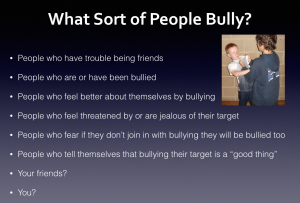Anti-Bullying Teacher Programme 2 (diary entry)
- jamie03066
- Oct 6, 2022
- 3 min read

05.10.2022 The continuation of my Anti-Bullying Teacher Consultation broke down how to present the concept of bullying to 9-14 year olds. However, before we explored this topic with Drum Kempo Ju Jitsu and Fitness, we had another re-examination of our teaching landscape. This is best explained in my "3 Tribes" vlog on the subject, which can be found here. I was impressed by the work DKJF do in intervention and mediation. They actively work not just with victims of bullying but also bullies. Such an approach goes into long-term self-protection and sets a good example for other clubs who want to make a difference in society. We then moved onto discussing the nature of bullying, which I broke down into bullet points. The content of these bullet points might seem overly simplistic to adult teaching eyes, but they are targeted at the 9-14 age range and put in a specific order to prompt discussion in the group. Below I will explain how each of these bullet points helps teach important points for students to understand. What Sort of People Bully? People who have trouble being friends Here we immediately address the point of insecurity exhibited by many types of bully. Bullying might be broadly defined as an abuse of power. An individual who doesn't immediately connect to others due to disproportionate levels of low or high self-esteem might resort to more forced means to gain attention and win support, part of that might be persecuting others. People who are or have been bullied We touch on the cycle of abuse early on. Understanding that a person bullying has already been bullied or is being bullied might be key to a victim seeking resolution in the long-term. People who feel better about themselves by bullying This is a direct continuation of the cycle of abuse theme. People who feel threatened by or are jealous of their target Although bullying is categorised as a form of asocial, predatory antagonism there is sometimes a social root. An individual who feels their position in the social hierarchy has been threatened might lash out at their enemy and then turn this into a continued persecution. Therefore, although the bullying campaign is an act of predation it might have started with the bully feeling disrespected and disempowered. People who fear if they don’t join in with bullying they will be bullied too This point now takes us into the pack mentality, shifting the focus off a lead bully or a person initiating bullying and onto their followers, supporters and enablers. Many people bully as an act of survival. They join in with the bullying to protect themselves from being bullied. Some of those who join in can do more harm than the initiator due to trying to make up for lost time or because of cognitive dissonance. People who tell themselves that bullying their target is a “good thing” The term "Witch Hunt", taken from the late medieval and early modern age persecutions of individuals who were accused of performing acts of witchcraft, is an apt metaphor for a type of bullying driven by a cause. Those who abuse their power justify what they are doing on a supposed moral or ethical basis. They vilify their target to an audience who will be sympathetic the bully's professed cause. Your friends? Now we bring the discussion closer to home. Up to this point, all the above topics might discussed in an abstract manner. This is where we get down to the more sensitive and arguably more effective business of direct self-protection work. Peer pressure, Lampwicks and dangers within are discussed in my podcasts "Pinocchio's Valentine and the Handshake Hit" (available as a video in this link) and "Convince a Little Man". The latter also ties in the previous "Witch Hunt" topic. You? It is important to be self-reflective if we are going to address the topic of bullying with any degree of seriousness. Many people - and I would argue most - have been party to bullying in some way. By recognising bullying and getting students to do the same, we have a better change of managing the problem. https://clubbchimera.com/services/













Comments